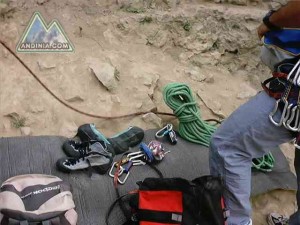
In this article we focus on how to perform maintenance, care, control and monitoring of personal protective equipment (PPE) designed to provide assurance at height activities or protection in case of falls.
This is material that is used in activities and sports of various kinds, whether climbing in all its forms (“climbing gear”), and to practice general mountaineering, canyoning, via ferrata, caving, use zip lines and rappelling , work at heights or other diverse outdoor activities (whether recreational, employment or training) where equipment is used which directly depends on our individual safety and / or group.
Preparing climbing equipment.
Tracking status of safety equipment is required to reduce the chances of any accident or mishap. This involves keeping track of this material safety from the moment of purchase, thus guaranteeing its integrity during use or detecting any failure in advance.
Material security and assurance for work at height and safety from falls, can in principle be divided into two groups, which may be known of its definition following the links below:
Soft material. Team-based textiles, among which we include ropes, harnesses, belts rings, climbing shoes, or cordines slings, quickdraws, hammocks, wall, boatswains, etc.
Such materials are sensitive to friction and general environmental conditions (sunlight, moisture, temperature, etc.) so that its lifetime is limited to a certain amount of time determined by the manufacturer, that duration begins to counted from the moment of its production, although it remains stored in the best possible condition and unused.

Hard material. Team-based metal alloys and may include resistant, such as carabiners, descenders, insurers, ice axes, crampons, helmets, brakes, chocks and stoppers, blockers, pulleys, nails, friends, quick links, ice axes, snow anchors, stakes plastic parts Snow, anchors, etc. There is a caveat in this definition: in some cases it is considered “hard” material solely those incorporating metallic materials.
However, the truth is that many incorporate plastic parts , and many manufacturers include it in this category. The distinction is not merely academic, but influences regarding future retirement date apparatus as plastics usually have a limited life in all cases, while not necessarily metallic materials.
This type of equipment is not very sensitive to environmental conditions compared with the soft material, but it is more sensitive to drops, bumps and abrasions, which can cause the microcracks or weakening of material they are made (usually aluminum alloys plastics). So life is stipulated by the manufacturer, usually from the moment you start using, not while they are stored under optimal conditions without any use (unused).
The lifetime with occasional use and with proper care containing plastics is estimated between 5 and 10 to 12 years, depending on the item and manufacturer in question (for specifics, always guided by the specific manufacturer’s recommendations); while with frequent use and proper care, between 2 and 7 years. The life of an entirely metallic hard material, it may be indeterminate in principle, and only proceed to his retirement in case something affecting its integrity.

Leave a Comment